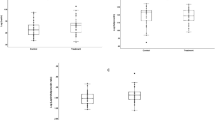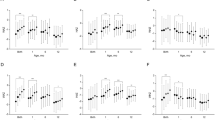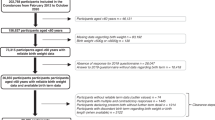Abstract
Background:
Preterm, very-low-birth-weight (PT-VLBW) neonates are at-risk for metabolic syndrome later in life. At 1–3 y, they exhibit excessive weight-for-length z-scores (Wt-LZ) and elevated systolic blood pressures (SBP). Serum adipokines are biomarkers of adiposity, but expression in PT-VLBW infants is unclear. We examined the correlation between serum adipokine levels, anthropometric measures and SBP in PT-VLBW neonates at follow-up.
Methods:
This was a cross-sectional cohort study of PT-VLBW infants at 1, 2, and 3 y of age (40/cohort). We measured SBP, abdominal circumference (AC) and anthropometrics; calculated age/gender-specific z-scores for Wt, L, Wt-L and subscapular skin fold (SSZ), and measured serum adipokines.
Results:
Serum leptin was unaffected by chronologic age and gender, but was positively correlated with weight, Wt-LZ, AC, and SSZ at 1 and 3 y (P < 0.01). Female infants at 1 and 3 y had a more significant relationship than males between serum leptin and SSZ (P < 0.001, R = 0.75 and P < 0.001, R = 0.70, respectively). Adiponectin levels were 16–20% lower at 3 vs. 1–2 y (P = 0.02, ANOVA) and negatively correlated with SBP.
Conclusion:
Although serum leptin was unrelated to advancing age, gender, and SBP in PT-VLBW infants, levels correlated with measures of adiposity at 1 and 3 y, females > males, suggesting leptin resistance may occur in early infancy.
Similar content being viewed by others
Log in or create a free account to read this content
Gain free access to this article, as well as selected content from this journal and more on nature.com
or
References
Johansson S, Iliadou A, Bergvall N, Tuvemo T, Norman M, Cnattingius S. Risk of high blood pressure among young men increases with the degree of immaturity at birth. Circulation 2005;112:3430–6.
Hofman PL, Regan F, Jackson WE, et al. Premature birth and later insulin resistance. N Engl J Med 2004;351:2179–86.
Parkinson JR, Hyde MJ, Gale C, Santhakumaran S, Modi N. Preterm birth and the metabolic syndrome in adult life: a systematic review and meta-analysis. Pediatrics 2013;131:e1240–63.
Calkins K, Devaskar SU. Fetal origins of adult disease. Curr Probl Pediatr Adolesc Health Care. 2001; 41:158–176.
Vickers MH, Sloboda DM. Leptin as mediator of the effects of developmental programming. Best Pract Res Clin Endocrinol Metab 2012;26:677–87.
Barker DJ, Osmond C, Forsén TJ, Kajantie E, Eriksson JG. Trajectories of growth among children who have coronary events as adults. N Engl J Med 2005;353:1802–9.
Belfort MB, Rifas-Shiman SL, Rich-Edwards J, Kleinman KP, Gillman MW. Size at birth, infant growth, and blood pressure at three years of age. J Pediatr 2007;151:670–4.
Duncan AF, Rosenfeld CR, Morgan JS, Ahmad N, Heyne RJ. Interrater reliability and effect of state on blood pressure measurements in infants 1 to 3 years of age. Pediatrics 2008;122:e590–4.
Duncan AF, Heyne RJ, Morgan JS, Ahmad N, Rosenfeld CR. Elevated systolic blood pressure in preterm very-low-birth-weight infants ≤3 years of life. Pediatr Nephrol 2011;26:1115–21.
Park HK, Ahima RS. Physiology of leptin: energy homeostasis, neuroendocrine function and metabolism. Metabolism 2015;64:24–34.
Abella V, Scotece M, Conde J, et al. Adipokines, metabolic syndrome and rheumatic diseases. J Immunol Res 2014;2014:343746.
Zachariah JP, Hwang S, Hamburg NM, et al. Circulating adipokines and vascular function: cross-sectional associations in a community-based cohort. Hypertension 2016;67:294–300.
Mantzoros CS, Magkos F, Brinkoetter M, et al. Leptin in human physiology and pathophysiology. Am J Physiol Endocrinol Metab 2011;301:E567–84.
Mi J, Munkonda MN, Li M, et al. Adiponectin and leptin metabolic biomarkers in chinese children and adolescents. J Obes 2010;2010:892081.
Reynolds CM, Gray C, Li M, Segovia SA, Vickers MH. Early life nutrition and energy balance disorders in offspring in later life. Nutrients 2015;7:8090–111.
Li S, Shin HJ, Ding EL, van Dam RM. Adiponectin levels and risk of type 2 diabetes: a systematic review and meta-analysis. JAMA 2009;302:179–88.
Taylor LE, Sullivan JC. Sex differences in obesity-induced hypertension and vascular dysfunction: a protective role for estrogen in adipose tissue inflammation. Am J Physiol Regul Integr Comp Physiol. 2016; 311: R714–R720.
Deng Y, Scherer PE. Adipokines as novel biomarkers and regulators of the metabolic syndrome. Ann N Y Acad Sci 2010;1212:E1–E19.
Catalán V, Gómez-Ambrosi J, Rodríguez A, et al. Association of increased visfatin/PBEF/NAMPT circulating concentrations and gene expression levels in peripheral blood cells with lipid metabolism and fatty liver in human morbid obesity. Nutr Metab Cardiovasc Dis 2011;21:245–53.
Lambert M, O’Loughlin J, Delvin EE, Levy E, Chiolero A, Paradis G. Association between insulin, leptin, adiponectin and blood pressure in youth. J Hypertens 2009;27:1025–32.
Frankfurt JA, Duncan AF, Heyne RJ, Rosenfeld CR. Renal function and systolic blood pressure in very-low-birth-weight infants 1-3 years of age. Pediatr Nephrol 2012;27:2285–91.
WHO Multicentre Growth Reference Study Group. WHO child growth standards: length/height-for-age, weight-for-age, weight-for-length, weight-for-height and body mass index-for-age: methods and development. Geneva: World Health Organization, 2006. pp. 312.
WHO Anthro for Personal Computers, version 2.0, 2007: Software for assessing growth and development of the world’s children. Geneva: WHO. 2006 http://www.who.int/childgrowth/software/en/.
WHO Multicentre Growth Reference Study Group. WHO child growth standards: head circumference-for-age, arm circumference-for-age, triceps skinfold-for-age and subscapular skinfold-for-age: methods and development. Geneva: World Health Organization, 2007. pp. 217.
Johansson S, Iliadou A, Bergvall N, Tuvemo T, Norman M, Cnattingius S. Risk of high blood pressure among young men increases with the degree of immaturity at birth. Circulation 2005;112:3430–6.
Tu W, Eckert GJ, DiMeglio LA, Yu Z, Jung J, Pratt JH. Intensified effect of adiposity on blood pressure in overweight and obese children. Hypertension 2011;58:818–24.
Wells JC, Cole TJ. Height, adiposity and hormonal cardiovascular risk markers in childhood: how to partition the associations? Int J Obes (Lond) 2014;38:930–5.
Savino F, Rossi L, Benetti S, Petrucci E, Sorrenti M, Silvestro L. Serum reference values for leptin in healthy infants. PLoS One 2014;9:e113024.
Erhardt E, Foraita R, Pigeot I, et al.; IDEFICS consortium. Reference values for leptin and adiponectin in children below the age of 10 based on the IDEFICS cohort. Int J Obes (Lond) 2014;38 Suppl 2:S32–8.
Flynn JT. Adiposity, the sympathetic nervous system, and childhood primary hypertension. Hypertension 2013;62:689–90.
Hinchliffe SA, Sargent PH, Howard CV, Chan YF, van Velzen D. Human intrauterine renal growth expressed in absolute number of glomeruli assessed by the dissector method and Cavalieri principle. Lab Invest. 1994; 64:777–784
Gubhaju L, Sutherland MR, Black MJ. Preterm birth and the kidney: implications for long-term renal health. Reprod Sci 2011;18:322–33.
Brenner BM, Garcia DL, Anderson S. Glomeruli and blood pressure. Less of one, more the other? Am J Hypertens 1988;1(4 Pt 1):335–47.
Hodgin JB, Rasoulpour M, Markowitz GS, D’Agati VD. Very low birth weight is a risk factor for secondary focal segmental glomerulosclerosis. Clin J Am Soc Nephrol 2009;4:71–6.
Hibino S, Abe Y, Watanabe S, et al. Proteinuria caused by glomerular hypertension during adolescence associated with extremely premature birth: a report of two cases. Pediatr Nephrol 2015;30:1889–92.
Weyer C, Funahashi T, Tanaka S, et al. Hypoadiponectinemia in obesity and type 2 diabetes: close association with insulin resistance and hyperinsulinemia. J Clin Endocrinol Metab 2001;86:1930–5.
Lai H, Lin N, Xing Z, Weng H, Zhang H. Association between the level of circulating adiponectin and prediabetes: a meta-analysis. J Diabetes Investig 2015;6:416–29.
Acknowledgements
This study was supported in part by the George L. MacGregor Professorship held by Rosenfeld. Frankfurt received a Young Investigator Award for the presentation of the leptin data at the 2011 annual meeting of the Pediatric Academic Societies. Thanks to the staff in the Low Birth Weight Clinic for assisting in the conductance of this study.
Author information
Authors and Affiliations
Corresponding author
Rights and permissions
About this article
Cite this article
Duncan, A., Frankfurt, J., Heyne, R. et al. Biomarkers of adiposity are elevated in preterm very-low-birth-weight infants at 1, 2, and 3 y of age. Pediatr Res 81, 780–786 (2017). https://doi.org/10.1038/pr.2017.11
Received:
Accepted:
Published:
Issue date:
DOI: https://doi.org/10.1038/pr.2017.11
This article is cited by
-
Follow-up of a randomized trial optimizing neonatal nutrition in preterm very low birthweight infants: growth, serum adipokines, renal function and blood pressure
Journal of Perinatology (2024)
-
Persistent high blood pressure and renal dysfunction in preterm infants during childhood
Pediatric Research (2023)
-
Quality improvement project designed to reduce disproportionate growth in extremely low gestational age neonates: cognitive neurodevelopmental outcome at 18–41 months
Journal of Perinatology (2021)
-
Optimizing individual nutrition in preterm very low birth weight infants: double-blinded randomized controlled trial
Journal of Perinatology (2020)
-
Association of age of initiation and type of complementary foods with body mass index and weight-for-length at 12 months of age in preterm infants
Journal of Perinatology (2020)



